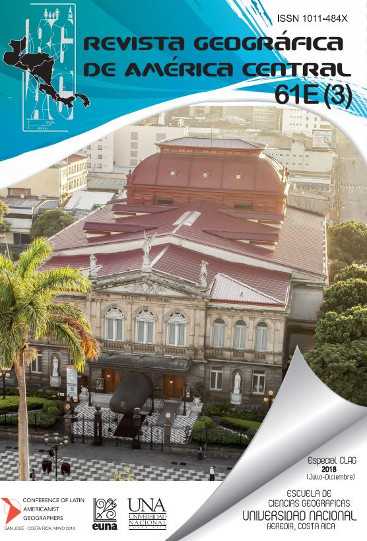‘Juntando a fome com a vontade de comer’: discussion on the implementation of cycle infrastructure as a way to promote social equity and sustainability in Prado, Bahia, Brazil.
DOI:
https://doi.org/10.15359/rgac.61-3.22Keywords:
Bicycling infrastructure; City; Sustainability; Social Inclusion.Abstract
Cycling in urban mobility is a beneficial habit of active transport. Researches affirm that urban cycling is associated not only with the availability of cycle infrastructure, favorable topography, urban form and mild climate, but mainly to the habit of pedaling. In Prado, a small historical and tourist city in northeastern Brazil, the bicycle is used by residents as one of the main means of transportation, despite the absolute lack of cycling infrastructure in the city. This article focuses on the possibilities of implementing a cycle network in this locality. A survey of local residents was conducted to understand cyclists' profile, patterns and travel frequency, as well as specific problems faced by cyclists in the city. This article discusses the preliminary results of this research. Both cyclists and non-cyclists who participated in the research agree that the implementation of cycling infrastructure would serve not only as a motivator for incorporating the bicycle as a means of daily transportation, but would impact the increase of frequency for those who occasionally use it. A cycle network in Prado would benefit the common resident throughout the year as well as tourists visiting the city. This approach, by diverging from the tradition of urban improvements often aimed at the central areas of American and Brazilian cities, becomes a good example of social equity, and sustainability.
References
Andrade, A. C. da S. e Dominguez, J. M. L. (2002). Informações Geológico-Geomorfológicas Como Subsídios À Análise Ambiental: O Exemplo Da Planície Costeira De Caravelas – Bahia. Boletim Paranaense de Geociências, n. 51, p. 9-17, 2002. Editora UFPR
Associação Nacional de Transportes Públicos – ANTP, disponível em http://www.antp.org.br/
Atlas Brasil, disponível em http://www.atlasbrasil.org.br/2013/pt/perfil_m/prado_ba
BANTEL, G. (2005) Bicicleta, Veículo não motorizado (VNM), Revista de Transportes Públicos – ANTP. Ano 27, 2º Trimestre, São Paulo. p. 59-68.
Barbosa, V. (2016). As capitais com mais ciclovias (e por que não comemorar). In Revista Exame, publicado em 9 jan 2014, 16h31 e revisado em 3 set 2016, 15h40. Disponível em: https://exame.abril.com.br/brasil/as-capitais-com-mais-ciclovias-e-por-que-nao-comemorar/
Caldeira, J. P. (2015). Implantação de ciclovias aumenta número de ciclistas em SP. Em Jornal de Todos os Brasis, disponível em: https://jornalggn.com.br/noticia/implantacao-de-ciclovias-aumenta-numero-de-ciclistas-em-sp.
Cervero, R., Caldwell, B. and Cuellar, J. (2013). Bike-and-Ride: Build It and They Will Come. Journal of Public Transportation, 16 (4): 83-105.
Departamento Intersindical de Estatística e Estudos Socioeconomicos – Dieese, disponível em: https://www.dieese.org.br/
Fu, L., & Farber, S. (n.d). Bicycling frequency: A study of preferences and travel behavior in Salt Lake City, Utah. Transportation Research Part A - Policy and Practice, 10130-50.
Goodyear, S. (2015). The Steady Rise of Bike Ridership in New York. Citylab, disponível em: https://www.citylab.com/transportation/2015/04/the-steady-rise-of-bike-ridership-in-new-york/390717/
Huang, C. (2015). An Exploratory Scenario for San Francisco to Become A Walking, Bicycling and Transit City.
Programa das Nações Unidas para os Assentamentos Humanos (ONU-Habitat). Disponível em https://nacoesunidas.org/agencia/onuhabitat/
Pucher, J., Komanoff, C., and Schimek, P. (1999). Bicycling renaissance in North America? Recent trends and alternative policies to promote bicycling. Transportation Research, vol. 33, pp. 625-654.
Scott, B., Amel, E., Koger, S., Manning, C. (2016). Psychology for Sustainability, 4th Ed. Routledge
Shrestha, K. K., Ojha, H. R., McManus, P., Rubbo, A., & Dhote, K. K. (2015) Inclusive Urbanization – Rethinking Policy, Practice and Research in the Age of Climate Change. 1st Edition, Routledge.
Silva, F. O. e Ferreira, W. R. (2016). Logística Urbana E Planejamento Territorial: Uma Abordagem Política. Revista Geográfica de América Central, Nº 56 pp. 39–55.
Soares, R. D. G. (2015). Bicicleta e mobilidade urbana - Modismo ou solução sustentável para o transporte na cidade de São Paulo. TCC, USP, SP.
Torres-Paniagua, M. e Hernández-Vega, H. (2017). Estudio De La Movilidad Ciclista En Un Sector De Los Cantones Cartago Y El Guarco, De La Provincia Cartago, Costa Rica. Revista Geográfica de América Central, Nº 58 pp. 223–251
Walker, B. (2014). Foreword. In Pearson, L., Newton, P. and Roberts, P., Resilient Sustainable Cities, A Future (p. xi). New York: Routledge.
Winters, M., Davidson, G., Kao, D., & Teschke, K. (2011). Motivators and deterrents of bicycling: Comparing influences on decisions to ride. Transportation, 38(1), 153–168.
Published
How to Cite
Issue
Section
License
Proposed policy for journals offering Open Access
Authors publishing their works in the Journal acknowledge and agree to the following terms:
a) Authors retain the copyrights to their works and guarantee the Journal the right to be the first to publish their works, under the Creative Commons License Attribution-NonCommercial-ShareAlike 4.0 International, CC BY-NC-SA 4.0 International (https://creativecommons.org/licenses/by-nc-sa/4.0/deed.es), which allows others to share works upon complying with the acknowledgment of authorship and mention of the Journal as the original publisher of the work.
b) Authors are permitted to separately establish additional agreements for the non-exclusive distribution of the official edition of the work published in the Journal (for example, authors may desire to place the work in an institutional repository or incorporate it into a book that is to published elsewhere) so long they acknowledgment to recognize the Journal as the original publisher. The aforementioned additional agreements must respect the terms of the non-profit character and sharing philosophy of the original license (CC BY-NC-SA 4.0 International, https://creativecommons.org/licenses/by-nc-sa/4.0/deed.es).
c) Authors are encouraged to archive the post-print or editor/PDF version in Open Access repositories.






 REVGEO is licensed under https://creativecommons.org/licenses/by-nc-sa/4.0/deed.es
REVGEO is licensed under https://creativecommons.org/licenses/by-nc-sa/4.0/deed.es
.svg_4.png)

_(1).png)
_(1)_(1)_(1)_1.png)
(2)(1)(1)(1).png)
